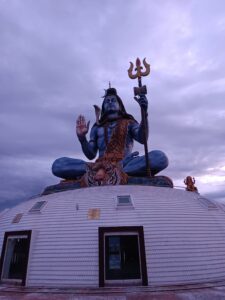महाशिवरात्रि: आध्यात्मिक जागरण की पावन रात्रि
(महाशिवरात्रि का महत्व, पूजन विधि और योग साधकों के लिए विशेष निर्देश)
महाशिवरात्रि का महत्व (शास्त्रों से प्रमाण सहित)
महाशिवरात्रि हिंदू धर्म में अत्यंत महत्वपूर्ण पर्व है, जो भगवान शिव की उपासना के लिए समर्पित है। यह पर्व फाल्गुन मास की कृष्ण पक्ष की चतुर्दशी को मनाया जाता है।
1. शास्त्रों में महाशिवरात्रि का उल्लेख:
शिव पुराण: इसमें कहा गया है कि महाशिवरात्रि की रात्रि को भगवान शिव तांडव नृत्य करते हैं, जो सृष्टि, पालन और संहार का प्रतीक है।
2 शिव विवाह कथा (शिव पुराण से)
एक समय माता पार्वती ने कठोर तपस्या की ताकि वे भगवान शिव को पति रूप में प्राप्त कर सकें। उनके तप से प्रसन्न होकर शिव जी ने उनसे विवाह किया। इस कथा के अनुसार, महाशिवरात्रि शिव और पार्वती के पावन विवाह की तिथि है।
स्कन्द पुराण: इसमें बताया गया है कि इस दिन शिवलिंग की उपासना करने से सभी पाप नष्ट हो जाते हैं और मोक्ष की प्राप्ति होती है।
लिंग पुराण: इसमें कहा गया है कि इस दिन रात्रि-जागरण और शिव पूजा करने से व्यक्ति जन्म-मरण के चक्र से मुक्त हो सकता है।
2. शिवलिंग की पूजा का महत्व
शिवलिंग अनादी और अनंत ब्रह्म का प्रतीक है। यह साकार और निराकार दोनों रूपों में शिव की उपासना का केंद्रबिंदु है।
3. महाशिवरात्रि क्यों मनाई जाती है?
इस दिन भगवान शिव और माता पार्वती का विवाह हुआ था।
इस दिन भगवान शिव ने कालकूट विष का पान करके सृष्टि को बचाया था।
यह रात्रि जागरण और ध्यान के लिए सबसे उपयुक्त मानी जाती है, जिससे व्यक्ति आत्मज्ञान प्राप्त कर सकता है।
महाशिवरात्रि पर पूजन विधि
1. प्रातःकाल स्नान और संकल्प
प्रातः जल्दी उठकर गंगा जल मिश्रित जल से स्नान करें।
साफ वस्त्र धारण करके शिव पूजा का संकल्प लें।
2. शिवलिंग का अभिषेक (Shivling Abhishek)
जल और दूध: शिवलिंग पर गंगाजल और कच्चे दूध से अभिषेक करें।
दही, घी, शहद और पंचामृत: ये सभी समग्र ब्रह्मांडीय ऊर्जा के प्रतीक हैं।
बेलपत्र और धतूरा: यह भगवान शिव को अत्यंत प्रिय हैं।
चावल और भस्म: शिव को अर्पित करने से व्यक्ति की आध्यात्मिक उन्नति होती है।
3. मंत्र जाप और ध्यान
“ॐ नमः शिवाय” मंत्र का जाप करें।
“महामृत्युंजय मंत्र” का जाप करने से सभी रोग और कष्ट दूर होते हैं।
रात्रि में ध्यान करें और शिव तत्व को आत्मसात करें।
4. रात्रि जागरण और कथा श्रवण
शिव पुराण की कथा का श्रवण करें।
ध्यान, भजन और कीर्तन के माध्यम से शिव आराधना करें।
योग साधकों के लिए महाशिवरात्रि पर विशेष साधना
1. ध्यान (Meditation)
महाशिवरात्रि को ध्यान के लिए सबसे उत्तम रात्रि माना गया है।
अजपा जप: “ॐ नमः शिवाय” का मानसिक जप करें।
अंतर मौन: आंतरिक मौन साधना करें और आत्मा से जुड़ने का प्रयास करें।
- Published in Uncategorized
Understanding the Nadis: Pathways of Energy in the Body

The concept of nadis plays a significant role in yogic philosophy and understanding our inner energy systems. These energy channels are pathways through which prana, the life force, flows, connecting various aspects of our physical, mental, and spiritual well-being. Let us dive into the intricate world of nadis to gain a deeper insight into their structure, function, and significance.
The Nature of Nadis
The word nadi originates from the Sanskrit root “nad,” which means movement or flow. These nadis are likened to sprouts originating from the navel region and extending throughout the body, branching up to the shoulders and beyond. According to yogic texts, there are 72,000 nadis spread across the body, forming a complex network through which kundalini shakti flows.
Kundalini shakti, often depicted as a coiled serpent, lies dormant within these nadis. It is through the awakening of kundalini that one can transcend ordinary existence and realize higher states of consciousness.
The Ten Principal Nadis
Among the vast network, ten nadis are considered significant, as they facilitate the transition of the ten vayus (vital energies). These nadis are:
Ida Nadi: Represents the lunar energy, governing calmness, intuition, and the left side of the body.
Pingala Nadi: Represents the solar energy, responsible for vitality, logic, and the right side of the body.
Sushumna Nadi: The central and most important nadi, associated with spiritual awakening and the path to enlightenment.
Gandhari: Governs the left eye.
Hastijihva: Governs the right eye.
Poosha: Connects to the right ear.
Yashasvini: Connects to the left ear.
Alambusha: Governs the region below the throat.
Kuhu: Related to the reproductive organs.
Shankhini: Governs the excretory system.
The Structure of the Nadi System
These nadis extend upward, downward, and in oblique directions, forming a web-like structure that joins together like a wheel. They are all under the control of one principal prana, which governs their flow and function. The Ida, Pingala, and Sushumna nadis hold the most prominence due to their direct connection to spiritual practices like meditation and pranayama.
The Spiritual Significance
Understanding the nadis is essential for anyone seeking to explore the inner dimensions of their body and mind. Activating and balancing these energy channels through yogic practices can lead to improved physical health, mental clarity, and spiritual awakening.
- Published in Uncategorized



